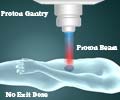Wireless delivery of light into the deep tissues of the body to suppress tumor growth by activation of light-sensitive drugs, potential targeted cancer therapy

‘The wireless delivery of light into the deep tissues of the body is made possible by tiny implantable devices that deliver doses of light over long time scales in a programmable and repeatable manner.’





While PDT is a powerful light-induced cancer treatment, it is often limited to surface cancers due to the low penetration of light through biological tissue. This wireless approach of light delivery enables PDT to be used on the inner organs of the body with fine control. This technology could potentially enable PDT to be used to treat a wider range of cancers, such as brain and liver cancer.Asst Prof Ho said, "Our approach of light delivery will provide significant advantages for treating cancers with PDT in previously inaccessible regions. Powered wirelessly, the tiny implantable device delivers doses of light over long time scales in a programmable and repeatable manner. This could potentially enable the therapies to be tailored by the clinician during the course of treatment."
Understanding photodynamic therapy
PDT is a treatment method that uses a light-sensitive drug called a photosensitizer, that is triggered by a specific wavelength of light, to produce a form of oxygen that kills nearby cells. This provides a precision approach to cancer therapy that overcomes many of the whole-body side effects of classical drugs such as chemotherapy. In addition to directly killing cancer cells, PDT shrinks or destroys tumors by damaging blood vessels in the tumor, preventing the cancer cells from receiving necessary nutrients. PDT may also activate the immune system to attack the tumor cells.
However, PDT has so far been limited to the treatment of surface cancers. Traditional light sources such as light-emitting diodes (LEDs) or lasers may be used for surface tumors, such as skin cancer, but the low penetration of light through tissue limits the depth to less than a centimeter. For the inner lining of some organs, such as the esophagus, an endoscope - a thin, lighted tube used to look at tissues inside the body - can be used to insert a fiber optic cable, but other regions cannot be easily accessed by this way. For organs such as the brain or liver, the organ must be exposed by surgery before PDT can be used.
Wireless light switch
The research team's novel approach of enabling PDT to be used for the inner organs of the body is achieved by inserting a tiny wireless device at the target site, extending the spatial and temporal precision of PDT deep within the body.
Advertisement
The team demonstrated the therapeutic efficacy of this approach by activating photosensitizers through thick tissues - more than three centimeters - inaccessible by direct illumination, and by delivering multiple controlled doses of light to suppress tumor growth.
Advertisement
The team is now working on developing nanosystems for targeted delivery of photosensitizers. They are also coming up with minimally invasive techniques for implanting the wireless devices at the target site, and looking into integrating sensors to the device to monitor the treatment response in real-time.
The complete research is published in the journal Proceedings of the National Academy of Sciences.
Source-Eurekalert














